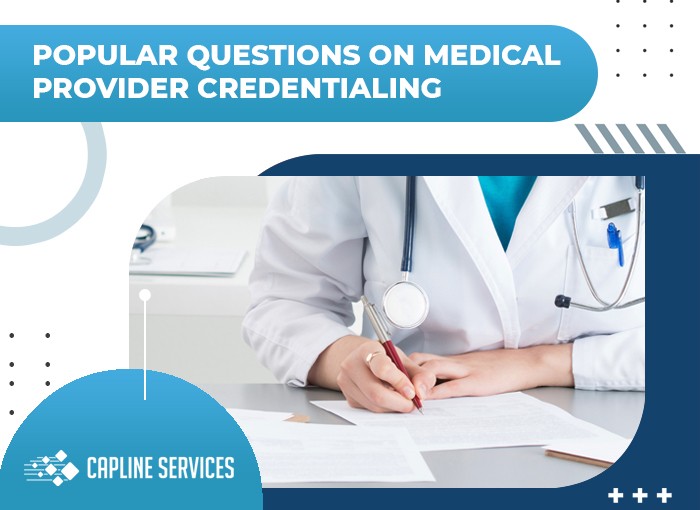Popular questions on medical provider credentialing
Credentialing is vital to ensure that medical providers are legal and competent in today’s evolving healthcare space. After all, every patient deserves the best care. If you are a provider or an administrator, you must understand what medical provider credentialing is. It is vital to comprehend how the process works and how much impact it holds on the viability of your practice.
Medical credentialing requires significant work. It involves evaluating several factors, including education, experience, residency, license, and certifications. With this complex process, it is obvious to have many questions regarding credentialing. This guide can help you answer most of those questions.
1) What is provider credentialing?
Provider credentialing or medical provider credentialing is a process by which insurance providers judge the qualifications and competence of a medical provider.
The insurance companies of the patients reimburse providers for their services. The reimbursement is possible after the provider passes credentialing requirements and is duly credentialed.
Once an insurance company credentials a provider, the provider joins the company’s insurance panel. Medical providers get on the insurance panel to get listed as the in-network providers. Providers can then treat patients who have that insurance health plan.
Joining insurance panels can significantly benefit any practice by expanding the pool of possible patients you can treat and providing your business with a sense of credibility.
2) What is the difference between provider credentialing and provider enrollment?
Provider credentialing and provider credentialing enrollment are linked yet distinct processes. The provider enrollment process involves enrolling a new provider with payors such as Medicare, Medicaid, or private payors to seek reimbursement.
Meanwhile, provider credentialing is obtaining and validating providers’ credentials and competencies to offer patient care. These processes must be completed before a new physician can begin delivering care at any healthcare facility.
3) How can I get credentialed?
Provider credentialing is a convoluted process that involves a lot of documentation. Healthcare providers provide the insurance company access to necessary records, reports, identifications, certifications, and other documents.
The insurance company reviews the provided documents and establishes whether the provider is fit to provide services to patients. If the provider is deemed fit, he is awarded a credential.
Process of Credentialing a provider:
A provider is credentialed only after going through each process mandated by the insurance company. The process includes
Gathering documents
Every Insurance company outlines specific requirements to process the credentialing application.
Commonly required documents include medical school diplomas, professional references, board certifications, records of any malpractice claims, proof of liability insurance, hospital affiliations, explanations of disciplinary actors against the provider, proof of continued medical education, and more.
Verification
The insurance company complies with the information and works to verify whether the information provided is true and accurate. In addition, insurance companies usually reach out to universities, licensing boards, or former employers to verify the qualifications.
Many insurance companies have automated this process, and they can do thorough background checks using specialized software.
Receiving credential
Collection and verification of the documents take months to complete. If the insurance company detects missing or inaccurate details, the process gets stalled indefinitely.
If the document processing and verification are completed without any error, the insurance company awards the provider a credential and lists them on their network.
4) What is CAQH?
CAQH (Coalition of Affordable Quality Healthcare) is an online database designed to help credential and enroll new providers.
Each insurance business offers its distinct credential. Therefore, a credential from one insurance company does not imply that you are qualified to handle patients from all insurers. Previously, credentialing applications were entirely different for almost every insurance carrier, making submitting your documents to many insurers (as most providers do) excruciating and time-consuming.
The process isn’t nearly as complicated now, thanks to CAQH. CAQH developed a universal application to collect information about providers’ professional backgrounds from them. In addition, providers can self-report their data to CAQH, allowing numerous insurance companies to discover it all in one spot.
CAQH is used by several of the largest insurers, including:
- Aetna
- Anthem
- Affinia Health Network
- Blue Shield of California
- EmblemHealth
- Cigna
- Humana
- GlobalHealth
- Lumeris
- Telecare
- US Vision
5) How frequently must a Provider be Credentialed?
In addition to completing the credentialing procedure for any new provider that joins your practice, you must also credential all existing physicians at least once every three years. Some payors need provider credentialing to be conducted even more frequently than this.
6) Is Credentialing and Privileging the same?
Insurance companies use credentialing to offer doctors the ability to see certain patients; hospitals use privileging to grant physicians the ability to perform specific treatments. Both the credentialing and privileging processes include evaluating the provider’s qualifications.
How can Capline Services help with the process of credentialing?
Capline Services excel at providing medical credentialing services to providers. We have established ourselves as one of the top medical credentialing companies in the United States.
Our team has assisted myriad healthcare practices in eliminating the stress of provider credentialing by doing most of the heavy lifting.
We have an outstanding record of providing medical credentialing services quickly and correctly by harnessing the latest automated technologies, an established process, a dedicated team, and years of collective experience.




